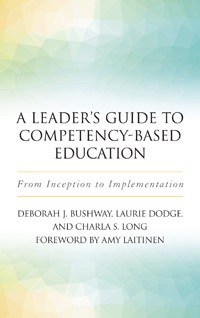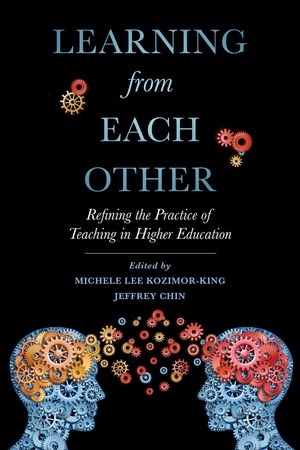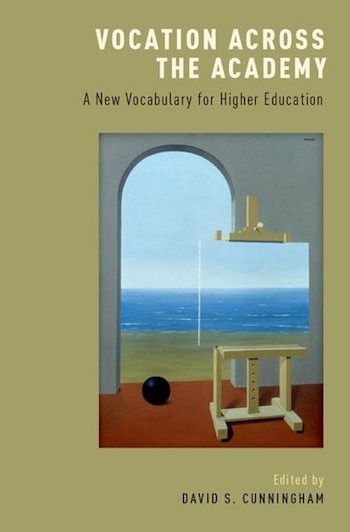higher education
Select an item by clicking its checkbox
Driftwood on a beach. How did it get here? From where? When? Why this beach? Why this day? And also, that it arrived, on the foam, with a bounty of neon green moss, stubbornly shining a light in the soggy sand. A beacon. Life will out. Blog originally ...
Date Reviewed: April 15, 2020
As faculty seek more effective learning and teaching practices, several disciplines have taken a “turn to reflective pedagogy” in recent years. Learning from Each Other: Refining the Practice of Teaching in Higher Education makes a substantive contribution to pedagogical practice in the discipline of sociology; this book is the result of workshops sponsored by the international honor society for the discipline. Contributors reflect a wide range of institutional types, teaching contexts, and research areas.
Following a brief introduction by the editors, the book is divided neatly into four parts: curricular innovations, classroom techniques, out-of-class situations, and assessment. Each chapter treats theory and strategy; this combination assures that topics are discussed with sufficient depth and adequate breadth of coverage across the discipline. References are included at the end of each chapter and the book closes with a useful index. Four of the twenty-one chapters in this book will be given attention here.
“Courting Controversy and Allowing for Awkward: Strategies for Teaching Difficult Topics,” by Mari Plikuhn, offers sound guidance applicable to any number of classroom discussions and contexts. The chapter addresses controversial content as well as classroom space; it includes helpful strategies for class structure and management. In “Becoming a Culturally Inclusive Educator,” Dena R. Samuels provides a guided sequence of practical steps for faculty engagement in this “transformative process” (203). The reader is encouraged to consider carefully the question of preparedness before working through the eight steps in this process. “The Value of Games and Simulations in the Social Sciences,” by Amanda M. Rosen, assesses the use of this active-learning strategy in a clear way. Rosen weighs barriers and incentives before addressing best practices. Finally, “Putting the Student at the Center: Contemplative Practices as Classroom Pedagogy,” by Tracey Wenger Sadd, supplies a succinct discussion of goals, outcomes, practices, and assessment of contemplative pedagogy. The chapter concludes with considerations and questions for determining the application of this pedagogy.
Instructors in Religious Studies and Theology are fortunate that these disciplines are strong in SOTL (scholarship of teaching and learning). These disciplines have a robust infrastructure for engaging in workshops, colloquies, and grant work to strengthen critical reflection on pedagogy. It is telling that instructors in these disciplines continue to produce and contribute highly impactful work on pedagogical research and practice that informs the national discourse. For this reason, there is much to be gained from this book. Discrete chapters may arouse interest in current trends, common questions, and shared efforts. Furthermore, attention to alternative perspectives on recurrent challenges and concerns distinct to a discipline can raise awareness. Finally, the recognition that higher education is growing ever more interdisciplinary makes this an opportune time to reflect on learning and teaching as a collaborative enterprise.
Date Reviewed: December 10, 2019
Against the backdrop of growing debate over both the nature and value of higher education, David Cunningham and twelve scholars offer what they believe may serve as a “common purpose” – vocation. Along with the word, “calling,” vocation has theological roots, but Cunningham argues that a “more expansive” approach to the word “is attentive to questions of profession, work, and employment” and “encompasses a much broader range of concerns that will arise during a college student’s current and future life.” The writers of this volume do not believe that appealing to the concept of vocation will eliminate conflict swirling around competing visions of the academy, but they do believe that the concept appeals to both the roots of the modern university and the goals of faculty from across the academy (3).
With that goal in mind, Cunningham and his co-contributors divide their effort into four parts. Eschewing a disciplinary-centered approach to their work, they instead consider “four different pathways or approaches through which the disciplines can come into conversation with one another: first by emphasizing certain themes that are common to them all; second, by borrowing concepts from one discipline that can apply to many other disciplines; third, by focusing on the future lives of undergraduates…; and fourth, by considering some of the institution-wide obstacles that need to be addressed if the language of vocation and calling is to be perceived as relevant to all academic departments and programs” (14).
In a closing epilogue, Cunningham notes that the volume demonstrates that neither vocation nor calling exhaust the concerns that arise from their use in the academy. The words, “responsibility, character, virtue, mission, covenant, mapmaking, storytelling, performance, work, [and] leisure,” along with others, figure in the contributions to this volume (315). That should come as no surprise, he argues. From the very beginning, Cunningham commends a definition of vocation that is “capacious, dynamic, and elastic” (315, cf. 10ff.).
Accordingly, he argues that one should approach the issue of vocation prepared to use multiple vocabularies that reveal different, but interrelated discoveries. To have a vocation means that one is shaped by that calling (317ff.); that one is summoned “from without” (319f.); that one must decide what to do (320f.); that those who are called inevitably consider their link to the callings of others (321f.); and that they are compelled to think about the impact their vocations will have on the future (322ff.).
This is the second of three volumes in an ambitious and welcome effort to recapture the inspiration of vocation as a locus for higher education. The first, published in 2015 under the title, At This Time and in This Place, focused on pedagogy. The third, published in January of 2019 appeared under the title, Hearing Vocationally Differently, and expands on the vocabulary associated with vocation, relying on contributors from diverse religious traditions.
One may well wonder what the prospects will be for the project of this series. Embattled as the academy is – by forces both within and without – one would hope that scholars will find a common inspiration that will lend new energy and focus to their work. But even cursory attention to the debates roiling college and university campuses underlines the truth that “an optimist is someone who is not in possession of all the facts.” It is difficult to believe that disciplines that are struggling to define a shared vision of the work that they are doing could agree on a vision for the larger work to which the whole academy is devoted.
The task that the writers propose is made all the more difficult by the choice of “vocation” as the organizing principle around which they attempt to rally their readers. As Cunningham himself observes, the verb vocare is transitive (317). As such, it implies that one is not only called, but one is also called by someone or something. The absence of a shared understanding of who or what issues that call - if anyone or anything does – underlines how little shared vision may be in the offing for the modern academy.
For theological educators the answer to that question and others ought to be easier to achieve, but anyone who teaches in the modern divinity school knows better than that. As seminaries struggle to address declining enrollments, degree programs are crafted with an eye to the individual’s goals and the notion of vocation – and the spiritual formation that accompanies it – has slipped again to the margins of theological education. Where it still lingers, it is necessarily governed by private definitions. In the meantime, seminary faculties differ with one another as much or more on such questions as the faculties at any college or university.
The effort made by Cunningham and his co-contributors comes, then, as both question and indictment: What is it about the concept of vocation that leads even a small but brave cohort of scholars without shared confessional commitments to imagine that they can galvanize their work around the concept? The indictment is this: What are the factors that have relegated the question of vocation to the margins of the very institutions that gave birth to the vocabulary?

Fundamentalists U: Keeping the Faith in American Higher Education
Date Reviewed: February 6, 2019
The aim of Fundamentalist U is to “offer a more complete history of fundamentalist and conservative evangelical higher education” including the daily functioning of evangelicalism. The schools studied include Wheaton University, Gordon College, Biola University, Moody Bible Institute, Bob Jones University, and Liberty University.
The task at all these schools is to balance academic legitimacy while maintaining reputations for religious purity. Laats defines the (evolving) distinctives of Christian fundamentalism and evangelicalism; outlines what it has meant for these schools to be “real” colleges or universities; demonstrates how the schools function as centers for both evangelicalism and fundamentalism; and examines the methods, models, and tools they have used to teach new generations of students.
The distinctive realm of Christian fundamentalism includes an interdenominational religious network of K-12 schools, colleges, universities, and Bible institutes dedicated to the promulgation of orthodox Christianity and to “remaining true to the supernatural truths of real religion as revealed once and for all in the pages of an inerrant Bible” (5). It means maintaining a belligerent stance against modernism, high levels of authority vested in personalities and charismatic leaders, a defense of Whiteness, and rigid positions on race which are elevated into tests of loyalty.
The distinctives of Christian fundamentalism (for example, conservatism) include a policing of all sexual behavior including homosexuality (which is framed as the ultimate sexual sin); traditional cultural attitudes around gender, family structure, and sexuality; and a constant monitoring of faculty and students regarding orthodox belief and action, in order, in part, to maintain their donor base, please fundamentalist parents, and ensure a regular flow of new students.
Laats examines evangelicalism’s evolution into neo-evangelicalism, characterized by a willingness to critically examine beliefs, preparing students for missionary work, and the grafting of small government, free-market ideologies onto theology. Changing ideas about civil rights and racial equality forced schools to admit that racial segregation was an important part of evangelical character, that racial integration was “anti-Christian perversion” and that, in the 1970s, a fear of miscegenation and opposition to school desegregation orders fueled the formation of thousands of new K-12 Christian schools. Laats also outlines how the six schools studied became important intellectual centers for religious and political conservatism.
The first unfortunate aspect of the book is that moderate black, brown, and white believers who are part of the evangelical tableau are not characterized. Second, a short section on what racism, anti-blackness, and white supremacy meant and still mean for African Americans is a much needed addition. That is, an acknowledgment that the toxic mix of equating whiteness with true Americanism, unqualified support of war, and the easy inclusion of conservative political orthodoxy with theology would have provided some ballast that most students and teachers would find useful pedagogically. Still, this is an excellent introductory text on (white) Christian fundamentalism and evangelicalism. It is well-researched, well-written, and a pleasure to read.

A Leader's Guide to Competency-Based Education: From Inception to Implementation
Date Reviewed: January 18, 2019
Recognizing the growing interest in competency-based education (CBE) in U.S. higher education, but also the lack of shared standards or practices around it, three experts produced this guide for other educators who are contemplating a move to (or revision of) this type of instructional program. The authors help those who are enthusiastic about CBE avoid pitfalls by offering practical guidance. They strike a cautionary tone throughout, beginning their Introduction with the sobering reality that “there are relatively few schools that have been able to move from interest to implementation” (1).
One of the reasons for caution may be that even a definition of CBE is hard to come by. The authors joke that “if you were to ask ten people to define CBE, you would likely hear ten different answers” (2). Instead they offer five “hallmarks” of CBE: (1) “time is variable, and learning is fixed”; (2) there is “required demonstration of mastery or proficiency” which is (3) “determined by rigorous assessments”; CBE is (4) “focused on the student learning journey” and is (5) “offered in a flexible, self-paced approach” (3-4). Many educational programs would claim one or more of these hallmarks, but taken together, they represent a distinct departure from traditional education. CBE’s most famous feature may be the way it changes the relationship between learning and time by replacing the credit hour with continuous direct assessment. As the authors demonstrate, however, this change complicates everything from the transcript to faculty workload to accreditation. CBE’s intense focus on individualized student learning paths and assessment (“assessment on steroids,” as I once heard) is also significant because it changes what learners actually do to learn and what teachers do to teach. Traditional faculty roles are likely to be unbundled, “reassembled” (89), and redefined – or replaced – by roles like coach, tutor, and psychometrician.
Given the challenge of defining CBE and the guide’s relative brevity, it would benefit from some case studies, at least for readers who are still trying to gain a clear picture of what a CBE program looks like and why an institution might adopt one in the first place. Cases would presumably also help CBE adopters appreciate why other institutions made the choices they did. The book reads instead like an insider’s guide.
The book’s best feature, accordingly, is its soup-to-nuts review of issues that educators must consider when designing competency-based education. Chapters address institutional culture, program design, assessment strategies, staffing and business models, and approval seeking. Readers come away fully aware that CBE is not just a different teaching approach but a potentially radical disruption to education delivery.


